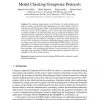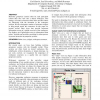129
Voted
ICCHP
2010
Springer
14 years 11 months ago
2010
Springer
Groupware systems allow remote collaboration via computer in a simple, economic and efficient way. However, to be universally valuable, groupware systems must be accessible and usa...
86
Voted
JUCS
2008
15 years 16 days ago
2008
: This paper describes the taxonomy for designing interactive groupware systems. The taxonomy defines the objectives, methods and principles for classifying models and facilitates ...
97
Voted
JUCS
2008
15 years 16 days ago
2008
: The design of the groupware systems is a progressively extended task, which is difficult to tackle. There are not proposals to support the joint modeling of collaborative and int...
116
Voted
COOP
2004
15 years 1 months ago
2004
Abstract. The enormous improvements in the efficiency of model-checking techniques in recent years facilitates their application to ever more complex systems of concurrent and dist...
120
click to vote
CAISE
2006
Springer
15 years 4 months ago
2006
Springer
The evolution of mobile technologies, like web-enable cellphones, PDAs and wireless networks, makes it now possible to use these technologies for collaborative work through web-bas...
136
Voted
AMAST
2004
Springer
15 years 4 months ago
2004
Springer
Distributed groupware systems consist of a group of users manipulating a shared object (like a text document, a filesystem, etc). Operational Transformation (OT) algorithms are app...
99
Voted
GROUP
2007
ACM
15 years 4 months ago
2007
ACM
Being aware of others' activities has played a vital role in the success of online collaboration. This resulted in the emergence of many groupware systems that provide users ...
99
Voted
CHI
1996
ACM
15 years 4 months ago
1996
ACM
Real-time groupware systems often let each participant control their own view into a shared workspace. This strategy can reduce awareness about where and how others are interactin...
108
click to vote
CHI
1996
ACM
15 years 4 months ago
1996
ACM
Shared physical workspaces allow people to maintain upto-the minute knowledge about others' interaction with the workspace. This knowledge is workspace awareness, part of the...
101
Voted
GROUP
1997
ACM
15 years 4 months ago
1997
ACM
Team automata have been proposed in Ellis (1997) as a formal framework for modeling both the conceptual and the architectural level of groupware systems. Here we define team autom...


